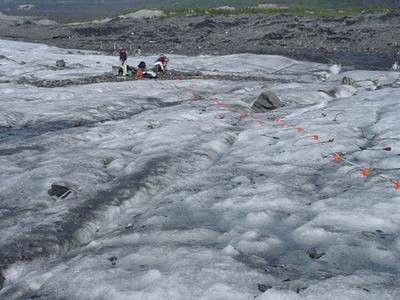4 August, 2002
Seismics on ice........
Today, Dr. Baker, his graduate students, several REU students, and myself
lugged all of the seismic gear up on the ice. The focus of todayıs work was
to attempt to locate the depth to the bottom of the ice. The set up was
more lengthy today for several reasons than when we ran seismics on soil.
The gear had to be packed a considerable up the glacier, and trust me itıs
not light. When seismic data is gathered on soil, the geophones simply push
into the ground, but on ice a tap hole must be hammered into the ice and
then the geophone coupled into the hole.
Once this data was collected, all the gear was packed back down off the ice,
and Dr. Baker, Laura Gilcrist (an REU student from the University at
Buffalo) and myself loaded up the GPR gear and headed back up onto the
glacier to collect data at the two boreholes that I have been studying.
We also attempted to run another experiment where we collected GPR data as a
weight was being lowered into a hole. Unfortunately, after setting the gear
up and beginning to lower the weight we found that the hole was only 20m in
depth. This hole was fairly close to the terminus of the glacier so the ice
would be expected to be thinner than further up the glacier, but 20m seems a
bit too thin even for this location. Dr. Baker speculated that what might
be happening is that sediments carried by subglacial streams may be backing
up and pushing up into the the bottom of this hole.
Tomorrow morning I am heading up to Fort Wainwright, a military station in
Fairbanks with Dr. Baker to do some GPR work. We will be using the radar to
look for depth to permafrost in much the same way I have described
previously using it to look for depth to buried ice. It will be a quick
trip as I will be back here at the glacier by Wednesday evening.
Life Is Good,
DT

The line of geophones set along a profile line on the glacier. The line along which the data was collected was 300m in length. This data will help reveal the depth to the bottom of the ice.
Contact the TEA in the field at
.
If you cannot connect through your browser, copy the
TEA's e-mail address in the "To:" line of
your favorite e-mail package.
|
